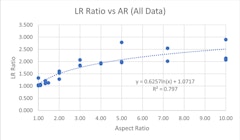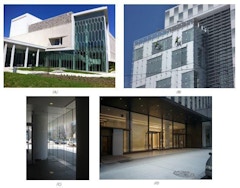
285 results
-
 Kintsukuroi, the Japanese art of repairing broken pottery with powdered precious metal, is a practice of celebrating the life and history of an…
Kintsukuroi, the Japanese art of repairing broken pottery with powdered precious metal, is a practice of celebrating the life and history of an… -

Iconic Buildings
- Paper by Xavier Ferrés Padró · Paula Martín Goñi
The iconic building principal incentive is to be visually attractive or stand out, for this purpose three main features must be accomplished: have a
-

Museum of Fine Arts, Houston
- Paper by Roman Schieber, Thorsten Helbig,
Steven Holl Architects designed two new buildings in the Museum District in Houston, Texas. Knippers Helbig is the facade consultant of both… -
Glass Strength Under Point Loading
- Paper by Joshua Schultz, Ph.D, P.E., LEED AP, ENV SP · John Knowles, PE SE · Kedar Malusare
Structural glass is used in a range of building applications, and while the ASTM E1300 has recently been updated to provide a design method to
-

Fixed Edge Supports
- Paper by James G. Soules, Ph.D., P.E., S.E., P.Eng., SECB, F.SEI, F.ASCE · Stephen M. Morse, Ph.D., P.E., M.ASCE · Scott H. Norville, P.E., Ph.D.
Model building codes and standards in the United States use a probabilistic model to define glass load resistance (LR). In general, these model
-
BioFacades Classification
- Paper by Mary Ben Bonham, Kyoung Hee Kim, Professor, Director of IDRL | Founder of EcoClosure Christiane M. Herr, Professor at the School of Design, Southern University of Science and Technology, Shenzhen
Coauthors: Mary Ben Bonham, Department of Architecture + Interior Design, Miami University, Oxford, OH, USA [corresponding] [presenting at the… -
Design and Energy Analysis
- Paper by Mahsa Farid Mohajer · Ajla Aksamija
Integration and interoperability between Building Information Modeling (BIM) and Building Energy Modeling (BEM) tools pose major challenges for the
-

Adaptive Building Envelope
- Paper by Abolfazl Ganji Kheybari, Ph.D. Candidate, Department of Art and Architecture, Science and Research Branch, Islamic Azad University, Tehran, Iran Jochen Lam,
Designing a multi-functional building envelope as an architectural façade, environmental interface and solar collector is a multi-objective… -

Hybrid Timber
- Paper by Stacey Hooper, AIA, LEED BD+C,
This case study provides an overview of building hybrid curtain wall system and future opportunities for the use of timber. It will also review the… -

Adaptable Glazing Shields
- Paper by Anas Al Kassas
Today, about 40% of all buildings in the U.S. still have single-pane windows, and ~70% of the existing building stock is estimated to suffer from
-

Glass and Electromagnetic Eavesdropping Protection
- Paper by Eric Stein
Glass is a key component in building design. Benefits of utilizing Insulating Glass Units (IGUs) within a building facade are well understood,
-

Reconfigurable Terracotta Facade
- Paper by Jin Young Song · Dan Vrana · Jonathan Hopp · Shawn Murrey · Jiatao Wu · Jongmin Shim
The traditional building facade as a permanent construction does not actively respond to the differing needs from varying weather conditions.
-
Thermal Stress Analysis in Glass
- Paper by Michael Elstner, Director of Technical Advisory Service Michaela Poláková, TAS Engineer Steffen Schäfer,
The use of glass in windows and curtain walls in residential as well as in commercial buildings needs to be designed very carefully. In addition to… -

Environmental Facade Perspective
- Paper by Patricia Shaw, M Arch., MSc Facade Engineering, Facade Specialist
Designing a sustainable rainscreen wall assembly has become an essential part of most new construction projects. Industry principles and energy codes… -

Mixed Reality in Facade Education
- Paper by Phillip Anzalone AIA · Amber Bartosh, RA LEED AP BD+C
Developments in performative computational analysis, mass customization, and complex form manipulation revolutionized building envelope design
-
Insulating Glass Unit Gas Loss
- Paper by Mark K. Schmidt, M.Eng., S.E. · Stephen M. Morse, PhD, P.E.
Concerns over time-dependent argon permeation through the perimeter edge seals of insulating glass units (IGUs) led the authors to utilize two
-

HydroSKIN
- Paper by Christina Eisenbarth, M.Sc. · Walter Haase, Dr.-Ing. · Lucio Blandini, Prof. Dr.-Ing. M.Arch. · Werner Sobek, Prof. Dr.-Ing. Dr.-Ing. E.h. Dr. h.c.
Building envelopes cover a considerable part of the urban exterior surfaces, and to therefore have a significant leverage effect on the climate
-

Design Considerations
- Paper by Stephen M. Morse, Ph.D. · Kayla Natividad, Ph.D. · H. Scott Norville, P.E., Ph.D.
Window glass design using ASTM E 1300 entails determining glass thickness(es) and types so that the window glass construction load resistance
-

Hardened Facades Effects on Structural Systems
- Paper by Aldo E. McKay, PE, Cliff A. Jones, SE, PE, PSP, Phillip Benshoof, PE,
To ensure the safety of U.S diplomatic personnel overseas, the U.S Department of State (DoS) has developed facade retrofits capable of resisting high…
